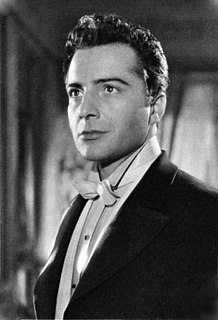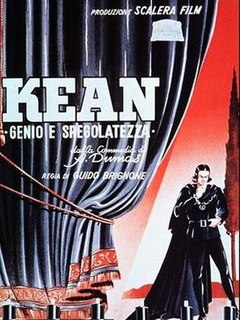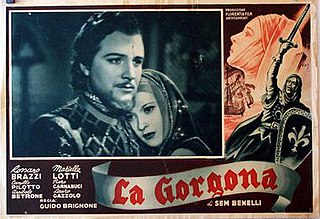
Maria Cebotari was a celebrated Bessarabian-born Romanian soprano and actress, one of the greatest opera and singing stars in the 1930s and 1940s.

Rossano Brazzi was an Italian actor.

Renato Cialente was an Italian stage and film actor. He appeared in 40 films between 1920 and 1943. His younger sister Fausta Cialente (1898-1994) was a novelist, journalist and political activist.

Milady and the Musketeers is 1952 French-Italian historical adventure film directed by Vittorio Cottafavi and starring Rossano Brazzi, Yvette Lebon and Armando Francioli. It is based on the 1844 novel The Three Musketeers by Alexandre Dumas, and was a popular success.

The Woman Who Invented Love is a 1952 Italian historical melodrama film written and directed by Ferruccio Cerio and starring Silvana Pampanini, Rossano Brazzi and Mariella Lotti.
Son of the Hunchback is a 1952 French-Italian historical adventure film directed by Fernando Cerchio and starring Rossano Brazzi, Milly Vitale and Gabrielle Dorziat.

The Mistress of Treves is a 1952 historical drama film directed by Arthur Maria Rabenalt and starring Rossano Brazzi, Anne Vernon and Gianni Santuccio. Made as a co-production between France, Italy and West Germany, it was filmed at a studio in Milan and on location in the Aosta Valley. It is based on the legend of Genevieve of Brabant and is set during the time of the Crusades.
The King's Jester is a 1941 Italian historical drama film directed by Mario Bonnard and starring Michel Simon, María Mercader and Rossano Brazzi. The film is an adaptation of the play Le roi s'amuse by Victor Hugo and uses music from Verdi's later opera Rigoletto. It is set at the court of Francis I of France in the Sixteenth century.

Bridge of Glass is a 1940 Italian drama film directed by Goffredo Alessandrini and starring Isa Pola, Rossano Brazzi and Filippo Scelzo. It was shot at the Scalera Studios in Rome.

The Courier of the King is a 1947 Italian historical film directed by Gennaro Righelli and starring Rossano Brazzi, Irasema Dilián and Valentina Cortese. It is an adaptation of the 1830 novel The Red and the Black by Stendhal. It was the final film of the veteran director Righelli, who had previously directed a silent version of the story in 1928.

Il conte Aquila is a 1955 Italian historical drama film directed by Guido Salvini. Inspired to real life events of Italian revolutionary Count Federico Confalonieri, it is based on the drama with the same name by Rino Alessi.

Condemned to Hang or Flesh for the Gallows is a 1953 Italian-Spanish historical adventure film directed by Ladislao Vajda and starring Rossano Brazzi, Fosco Giachetti and Emma Penella. The film portrays the bandits of nineteenth century Andalucía. The film's art direction was by Alberto Boccianti.

The Vampire of the Opera is a 1964 Italian horror film co-written and directed by Renato Polselli and starring Marco Mariani and Giuseppe Addobbati.
The Two Mothers is a 1938 Italian drama film directed by Amleto Palermi and starring Vittorio De Sica, María Denis and Renato Cialente.
Honeymoon with a Stranger is a 1969 American made-for-television mystery-thriller film starring Janet Leigh, Rossano Brazzi, Cesare Danova, Eric Braeden and Barbara Steele. Directed by John Peyser and based on the French play Piège pour un homme seul by Robert Thomas, the film premiered as the ABC Movie of the Week on December 23, 1969.

Kean is a 1940 Italian historical drama film directed by Guido Brignone and starring Rossano Brazzi, Germana Paolieri. and Sandro Salvini. It is based on the 1836 play Kean by Alexandre Dumas portraying the life of the English actor Edmund Kean.

The Gorgon is a 1942 Italian historical drama film directed by Guido Brignone and starring Mariella Lotti, Rossano Brazzi and Camillo Pilotto. It was adapted from the play by Sem Benelli and is set in the Republic of Pisa during the eleventh century.

The Dream of Butterfly is a 1939 musical drama film directed by Carmine Gallone and starring Maria Cebotari, Fosco Giachetti and Germana Paolieri. It is an variation of the plot of the opera Madame Butterfly. A co-production between Italy and Germany, two separate versions were produced in the respective languages. It is also alternatively titled Madame Butterfly. It was one of several opera-related films directed by Gallone following on from Casta Diva (1935) and Giuseppe Verdi (1938).

The Hero of Venice is a 1941 Italian historical adventure film directed by Carlo Campogalliani and starring Gustav Diessl, Paola Barbara, Rossano Brazzi and Valentina Cortese.















